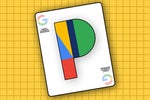Remember Wear OS — Google's platform for smartwatches and other wearable devices? (It used to be called Android Wear. If you didn't realize it had been rebranded or maybe didn't even realize it was still around, well, you could be forgiven.)
This week, Google announced it was working on a revamp — yes, another one — aimed at injecting the platform with fresh energy and purpose. It's a pretty significant update that reimagines the core interface of a Wear OS smartwatch and reassesses the very foundation of what such a device should be.
The primary points? Providing easier access to notifications and health tracking services and delivering more proactive info from the Google Assistant — now available in a dedicated feed to the left of the main home screen! — and, more broadly, making everything more glanceable, more simple to use, and less multiple-step-requiring.
Wait a minute. This all sounds eerily familiar. Let's rewind our brains for a moment, shall we? Magic quote-finding machine, take me back to 2014:
Google's early-2014 launch of the Android Wear platform did exactly what I had been hoping a smartwatch would come along and do: It provided a simple interface for the sorts of things that actually made sense for the form — things like smart notification management, smart on-the-go input, and smart context (via Google Now).
Sure, the platform also had support for sensors and all that other fancy stuff — but it was what Wear didn't try to be that made it especially interesting. Unlike other wearable-tech efforts, the platform didn't try to cram lots of tiny buttons and complex commands into an awkward-to-use wrist-based screen. It reframed the smartwatch to be less about performing grand tasks and more about transmitting pertinent info quickly and without fuss. Even today, that simplicity and notification-first focus (with both regular notifications and predictive Now-powered alerts) sets Wear apart from the more complicated and app-centric setups other smartwatch platforms provide.
Ah, right: When Wear first debuted, it was all about simple interactions and easy access to pertinent info — be it an incoming notification or a proactive alert about heavy traffic to somewhere you were likely to be heading. Thanks to Google's then-stellar Google Now service, Wear was in a unique position to take that type of data and put it front and center on your wrist, where it'd feel like a natural extension of your body instead of an out-of-the-way interruption.
But then, well, something happened: The early Wear devices weren't selling like hotcakes — and Apple's well-marketed alternative, on the other side of the mobile universe, was striking a chord with tech-hungry shoppers. So Google decided to take a little time-out and reassess its smartwatch strategy.
Self-quoting genie, hook me up again:
The Apple Watch came along, complete with its overly complicated interface and app-centric nature (something Apple would refine somewhat over time but that was almost laughably bad in the beginning). And Google, rather than sticking to the parts of its platform that made sense, decided to revamp Wear entirely and parrot Apple's flawed approach.
With 2017's Wear 2.0 update, Android Wear lost the core element that made it sensible as a wearable operating system — the focus on easily glanceable info from both notifications and predictive intelligence — and instead put the focus on things that sound impressive in ads but don't make for a great real-world experience on a tiny wrist-based screen: complicated standalone apps, cramped on-screen keyboards, and notifications that don't appear in a glanceable way and require multiple taps and interactions to process.
That was from a column earlier this year entitled "Google is often its own worst enemy" — a headline whose message seems especially appropriate today.
As I said back then, Google got it right in the beginning — at the base level, at least — but then failed to stick with its vision. Rather than finding a way to refine and then market its concept and make sure people understood why it made sense, Google gave up and blindly emulated Apple instead. The company's lack of commitment and conviction bit it in the keister yet again, in other words; Google acted as its own worst enemy, and we all saw how the resulting strategy played out.
Now, here we are, a year and a half down the road from that ill-fated overhaul, and Google's doing another one of its classic 360s — flip-flopping and going back to its original base concept after abandoning it for all the wrong reasons. It's an all-too-common tale with Google these days, whether we're talking about its Google Now desertion and (slow and ongoing) subsequent rebuilding or the comical messaging service saga that basically brought the company right back to where it started, 13 years and approximately 30,000 app launches later.
 Google
Google
With Wear, the real question now is if it's too little, too late. Can a pivot back to the progression Google should have been making with smartwatches ages ago win over consumers and/or business users today? Does anyone still want a Wear OS smartwatch? Does anyone still care?
The answer, I think, is an unsatisfying "maybe." As usual with Google, it ultimately depends on a few unpredictable factors — namely implementation, marketing, and availability. If Google manages to make appealing devices to showcase its revamped operating system (either on its own, as is rumored, or via the usual cast of platform partners); if it manages to convince developers to update their apps for optimal support of the new software; if it finds a way to make regular users aware of these products and the strengths their Google-associated software can offer; and if it succeeds at placing said products where shoppers will actually find 'em, then this might just be the push that gets Wear OS back on track — or at least more on track than it has been as of late.
To be sure, those are pretty big ifs, given Google's track record in all of those areas. But picking up where Wear should have been three years ago is better than numbly charging forward toward an obvious dead end.
And you know what else? Having the Google Assistant's predictive intelligence feed to the left of the Wear OS home screen makes me just a teensy bit hopeful that the next classic Google 360 will bring Google Now back to its proper home at the heart of Android itself — to the left of a phone's home screen — with a different name, of course, but basically just picking up where Google left off long ago, before the last silly pivot.
I don't know about you, but all this spinning is starting to make me dizzy.
Sign up for JR's new weekly newsletter to get this column along with bonus tips, personal recommendations, and other exclusive extras delivered to your inbox.

[Android Intelligence videos at Computerworld]




















































































